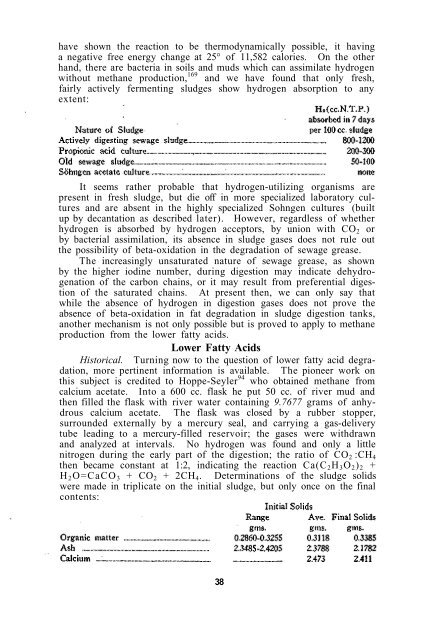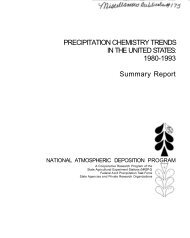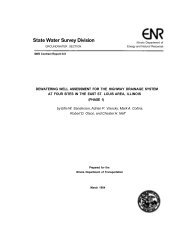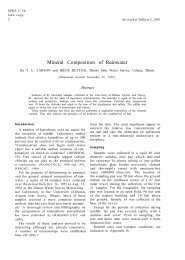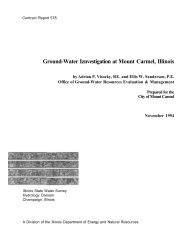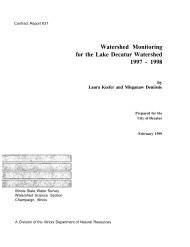Laboratory studies of sludge digestion. - Illinois State Water Survey
Laboratory studies of sludge digestion. - Illinois State Water Survey
Laboratory studies of sludge digestion. - Illinois State Water Survey
You also want an ePaper? Increase the reach of your titles
YUMPU automatically turns print PDFs into web optimized ePapers that Google loves.
have shown the reaction to be thermodynamically possible, it having<br />
a negative free energy change at 25° <strong>of</strong> 11,582 calories. On the other<br />
hand, there are bacteria in soils and muds which can assimilate hydrogen<br />
without methane production, 169 and we have found that only fresh,<br />
fairly actively fermenting <strong>sludge</strong>s show hydrogen absorption to any<br />
extent:<br />
It seems rather probable that hydrogen-utilizing organisms are<br />
present in fresh <strong>sludge</strong>, but die <strong>of</strong>f in more specialized laboratory cultures<br />
and are absent in the highly specialized Sohngen cultures (built<br />
up by decantation as described later). However, regardless <strong>of</strong> whether<br />
hydrogen is absorbed by hydrogen acceptors, by union with CO2 or<br />
by bacterial assimilation, its absence in <strong>sludge</strong> gases does not rule out<br />
the possibility <strong>of</strong> beta-oxidation in the degradation <strong>of</strong> sewage grease.<br />
The increasingly unsaturated nature <strong>of</strong> sewage grease, as shown<br />
by the higher iodine number, during <strong>digestion</strong> may indicate dehydrogenation<br />
<strong>of</strong> the carbon chains, or it may result from preferential <strong>digestion</strong><br />
<strong>of</strong> the saturated chains. At present then, we can only say that<br />
while the absence <strong>of</strong> hydrogen in <strong>digestion</strong> gases does not prove the<br />
absence <strong>of</strong> beta-oxidation in fat degradation in <strong>sludge</strong> <strong>digestion</strong> tanks,<br />
another mechanism is not only possible but is proved to apply to methane<br />
production from the lower fatty acids.<br />
Lower Fatty Acids<br />
Historical. Turning now to the question <strong>of</strong> lower fatty acid degradation,<br />
more pertinent information is available. The pioneer work on<br />
this subject is credited to Hoppe-Seyler 94 who obtained methane from<br />
calcium acetate. Into a 600 cc. flask he put 50 cc. <strong>of</strong> river mud and<br />
then filled the flask with river water containing 9.7677 grams <strong>of</strong> anhydrous<br />
calcium acetate. The flask was closed by a rubber stopper,<br />
surrounded externally by a mercury seal, and carrying a gas-delivery<br />
tube leading to a mercury-filled reservoir; the gases were withdrawn<br />
and analyzed at intervals. No hydrogen was found and only a little<br />
nitrogen during the early part <strong>of</strong> the <strong>digestion</strong>; the ratio <strong>of</strong> CO2 :CH4<br />
then became constant at 1:2, indicating the reaction Ca(C2H3O2)2 +<br />
H2O=CaCO3 + CO2 + 2CH4. Determinations <strong>of</strong> the <strong>sludge</strong> solids<br />
were made in triplicate on the initial <strong>sludge</strong>, but only once on the final<br />
contents:<br />
38


